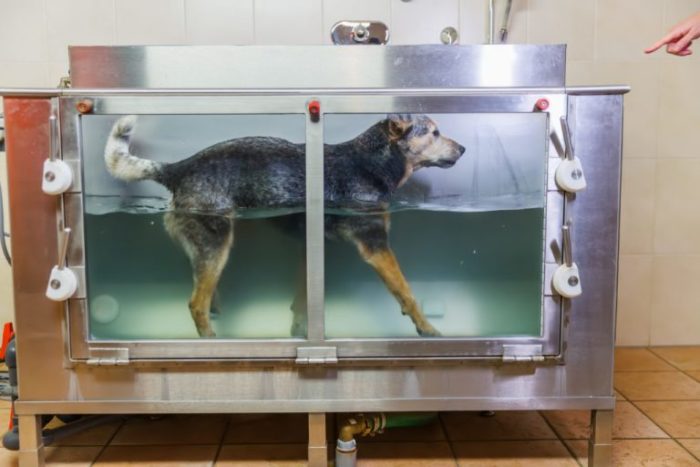Yes, a dog with luxating patella can be walked but pet parents ought to take serious precautions before taking the affected dog out for a walk. In the first place, it must not be stressed and the dog needs not walk on rough or slippery surfaces. Walking on grass may be preferable. Notably, the luxating patella can be treated, depending on its severity.
Table of Contents
What is Luxating Patella?
Normally, the kneecap (patella) of a pup balances on a groove or hollow at the lower end of its thigh bone (femur). As the knee flexes and extends, it will be moving up and down. In some canines, their patella will luxate (dislocate). Thus, a luxating patella can be explained as a kneecap that has popped out of its thighbone groove, veering inwards (medial) or outward (lateral) from the dog’s leg.
Signs of a Luxating Patella
- A luxating patella will cause a change in a dog’s stride
- The dog will tend to hop on the affected limb if the kneecap is popped out
- The dog may hold the limb up or stretch it out backward in order to return the kneecap to its normal position
- The dog will start walking normally once the kneecap returns to its normal position
How do You Diagnose the Condition?
Luxating Patella can be diagnosed at the puppy stage. When pet parents notice any abnormality in their canine friend’s movement, they should take it to the vet for a physical exam. At this point, the vet will now determine the grade based on the severity of the situation.
Grade 1 – Whenever the kneecap pops, it can return to position quickly and remain there
Grade 2 – The kneecap pops out more readily, though it can stay put in its normal position most of the time
Grade 3 – Here, the kneecap goes out of its groove usually and a manual rest is required to return it to position
Grade 4 – The kneecap is not just always out of the groove, it is impossible to push it back in. This is the most severe level
What Causes Luxating Patella?
- Hip dysplasia
- Growth deformities that may bend the limb
- Under-muscled or over-tight quadriceps muscles
- If the femur groove is too shallow
- When the tibia is misshaped and the part that a dog’s patella ligament is to be attached to happens to be in the wrong place
Above all, a luxating patella is listed as an inherited condition in dogs and occasionally, it can occur as a result of a traumatic injury.
Can a Dog Run With Luxating Patella?

When you notice that your pooch has developed this health condition, there is no need to make it run. At this stage, a long leisurely walk will be preferable. However, you must be careful in choosing your exercise ground. Avoid slippery surfaces like mud and hard surface that can have a severe impact on a dog’s joints. Soft surfaces are preferable. Also to be avoided are activities that will necessitate twisting and jumping like “catch”.
A good option for a dog with this condition is an underwater treadmill (dog hydro therapy); this can be done under the supervision of a vet whose area of specialty is rehabilitation therapy. With this, the dog will be kept lean and at the same, it supports its joints and maintains muscle mass.
How Long Can a Dog Live with Luxating Patella?
There are dogs that can complete their life span with luxating patella. This can only happen in small-sized pups. In this case, their condition may just be the grade one or two that does not come with much pain and won’t lead to arthritis.
Can You Prevent the Condition in Dogs?
The only way you can avoid luxating patella is simply to avoid breeding those pups that are sufferers of the condition.
Note, excessive weight tends to put too much strain on the knees of a pup, thus weight management should be taken seriously.
Dogs that already have this issue can be helped with nutritional supplements like fish oil. The fatty acid in fish oil douses pain and inflammation and slows the progress of arthritis.
Glucosamine, methylsulfonylmethane (MSM), and chondroitin sulfate can be very effective on joint pain.
Fast Facts
Can my dog live with a luxating patella?
Though toy breeds can live with the grade one and two levels of luxating patella, it is important to get all affected dogs treated to avoid the wearing down of the knee cartilages by the in and out movement in the patellar groove. Once the cartilage has worn off, there is bound to be bone-on-bone contact. In addition to causing excruciating pain in the joints, it can lead to permanent damage.
How do you fix a dog’s luxating patella?
This condition is treated according to severity – while grades three and four call for urgent surgery, a pup with a grade one and two of the luxating patella can be given none surgical treatments.
Below are some of the recommended non-surgical treatments for luxating patella
- A knee brace; this treatment ensures the restriction of a dog’s joint movement while walking
- Ice packs (cryotherapy); can be quite effective for traumatic joint problems
- Pain and anti-inflammatory medications; this kind of treatment must be recommended by a vet
- Physical therapy
- Exercise restriction
- Weight management
Read Also: 10 Sad Dog Movies That Will Make You Cry
Is luxating patella painful for dogs?
When the condition is at grade one or two, the dog may not experience any pain. Occasionally, pet parents can notice their pets skipping on three limbs for a short while and then revert it back to four limbs; this usually happens without any sign of pain from the affected canine. Dog owners who are not very observant may not even notice this.
However, it is a completely different case when the luxating patella is already at the third or fourth level. At this point, it is usually associated with pains and cannot correct itself except the dog is taken to the vet for either a manual reset or surgical procedure.
Can a luxating patella correct itself?
Grade one luxating patella can correct itself by popping back into position, but the same cannot be said for other levels.
